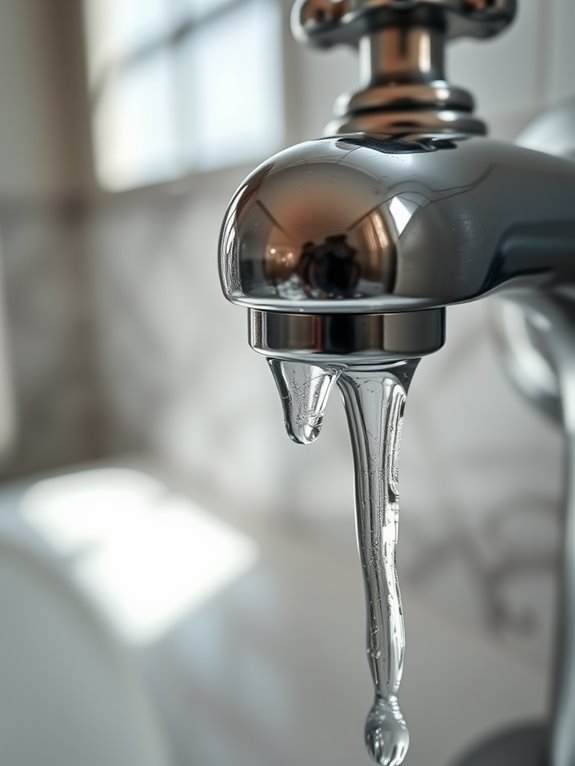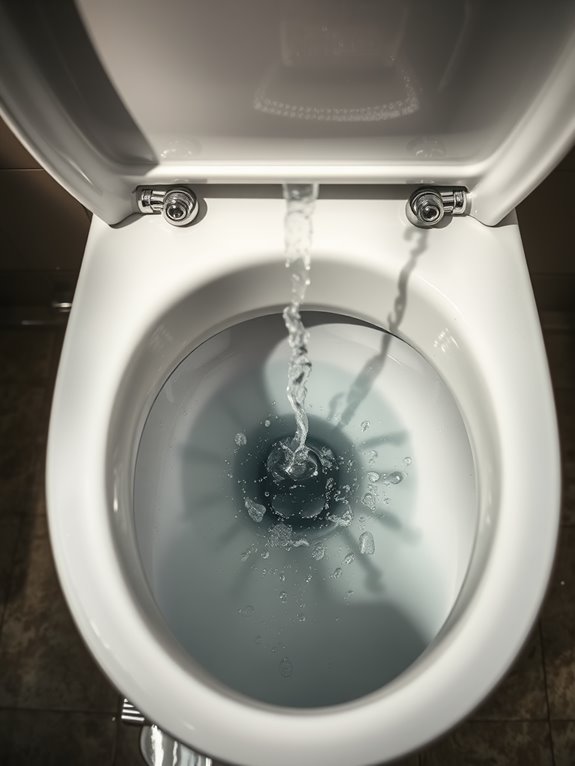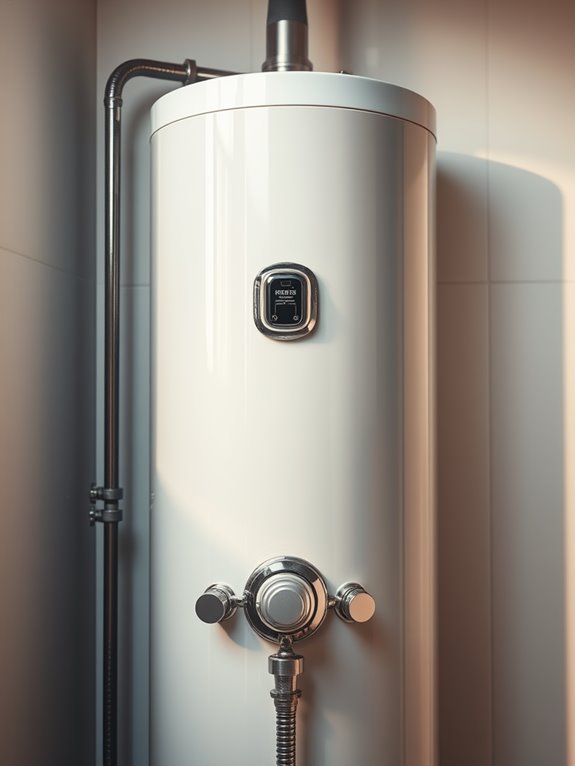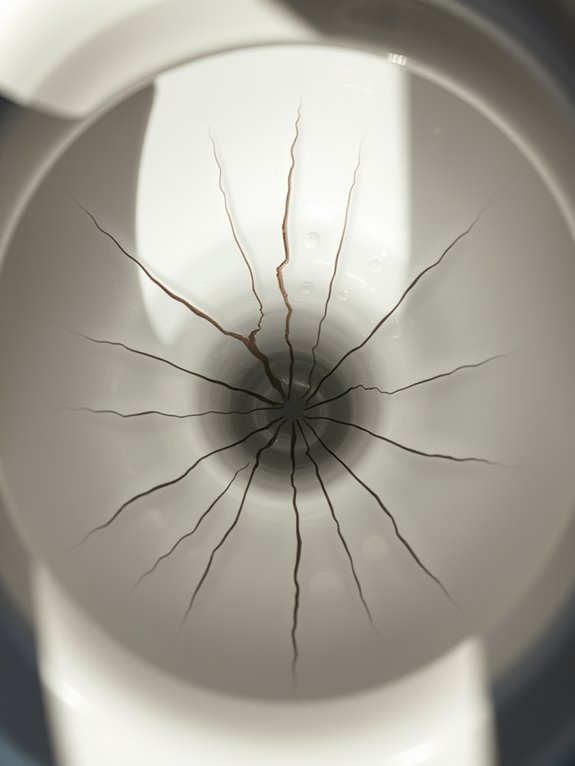Common Bathroom Plumbing Issues and How to Fix Them
Common bathroom plumbing issues include leaky faucets, clogged drains, running toilets, and low water pressure. To fix leaky faucets, inspect and replace worn washers. For clogged drains, use a plunger or a baking soda and vinegar solution. Check flapper valves for running toilets and make sure they’re properly aligned. If you notice low water pressure, inspect aerators and check for leaks. There’s more you can do to tackle these issues effectively, so keep going to learn further solutions.
Leaky Faucets

Leaky faucets can be a real nuisance, dripping away both your patience and water. If you’ve noticed a constant drip, it’s time to take action.
First, turn off the water supply and plug the drain to prevent losing any small parts. Remove the faucet handle, typically secured by a screw, and take a look at the cartridge or washer. If it’s worn or damaged, replacing it can often solve the problem.
Make sure to clean any mineral buildup while you’re at it. Once you’ve installed the new part, reassemble the faucet and turn the water back on.
Check for leaks, and if you’ve done it right, you’ll enjoy a drip-free experience and save water, too.
Clogged Drains
Clogged drains can really disrupt your daily routine, and they often stem from common issues like hair buildup or soap residue.
You might be able to tackle some clogs yourself with a few handy techniques, but knowing when to call a professional is key.
Let’s explore the causes, DIY fixes, and signs that it’s time to bring in the experts.
Common Causes of Clogs
While it might seem surprising, clogged drains often stem from everyday habits that you may not even think about. Hair is a major culprit, especially in shower drains, where it can easily accumulate and create blockages.
You might also notice that soap scum builds up over time, particularly if you use bar soap, leading to stubborn clogs. In bathroom sink drain installation, it’s important to consider how everyday items, like toothpaste and other grooming products, can contribute to clogs and drainage issues over time.
This way, the keywords are integrated naturally while maintaining the flow of the content.
Additionally, flushing inappropriate items like wipes or cotton swabs can create significant issues. Even mineral buildup from hard water can restrict flow in pipes.
DIY Clearing Techniques
When faced with a stubborn clog, there are several DIY techniques you can try before calling a plumber. Start with a plunger; it can work wonders for minor blockages. If that doesn’t do the trick, try a mixture of baking soda and vinegar. Pour half a cup of each down the drain, let it fizz for 30 minutes, then flush with hot water. For tougher clogs, you might need a plumber’s snake to break up the blockage.
Here’s a quick reference table for common DIY techniques:
| Technique | Steps | Effectiveness |
|---|---|---|
| Plunger | Create a seal, push, and pull | High for minor clogs |
| Baking Soda/Vinegar | Pour, let sit, flush | Moderate to high |
| Plumber’s Snake | Insert, twist, pull | High for tough clogs |
When to Call Professionals
Even after trying DIY techniques like plunging or using baking soda and vinegar, some clogs can stubbornly persist. When that happens, it’s time to call in the professionals.
If you notice water backing up, slow drainage, or foul odors that don’t go away, don’t hesitate to reach out for help. Persistent clogs might indicate deeper issues in your plumbing system, like tree roots or damaged pipes.
Professionals have the right tools, like drain snakes and hydro-jetters, to effectively address these problems without causing damage. Plus, they can identify potential issues before they escalate.
Don’t miss out on related tips: Read this next: How to fix a broken PVC drain pipe
Running Toilets

A running toilet can be more than just an annoyance; it can lead to higher water bills and wasted resources. If you’re dealing with this issue, you can often fix it yourself.
Here are some common causes to check:
- A worn flapper valve
- A faulty fill valve
- A chain that’s too tight or too loose
- A misaligned float
- Mineral buildup in the tank
Start by inspecting these components. Replace the flapper if it’s damaged, adjust the float to the right level, and clean any mineral deposits.
Regular maintenance can keep your toilet running smoothly. Remember, fixing a running toilet not only saves water but also helps you avoid unnecessary expenses.
Don’t let this minor issue turn into a bigger problem!
There’s more to explore! Here’s another valuable read: What Education Is Needed to Become a Plumber?
Low Water Pressure
Low water pressure can be frustrating, especially during those moments when you just want an invigorating shower or to wash your hands efficiently.
If you’re experiencing this issue, start by checking for any visible leaks in your pipes, as these can drastically reduce pressure.
Next, inspect your faucet aerators and showerheads for mineral buildup; a quick clean might do the trick.
If you’ve got a pressure regulator, it could be malfunctioning, so consider adjusting or replacing it.
Also, don’t forget to check your home’s main shut-off valve; it mightn’t be fully open.
If all else fails, calling a professional plumber might be the best option to resolve persistent low water pressure.
Water Heater Issues

If you’re running out of hot water too quickly, it could signal a problem with your water heater.
You might also notice unusual noises or leaks, which can indicate deeper issues that need attention.
Let’s explore these common water heater problems and how to address them.
Insufficient Hot Water
Why does your shower suddenly run cold when you need it most? Insufficient hot water can be incredibly frustrating, but there are common reasons for this issue.
Here’s what you might want to check:
- Thermostat Settings: Verify it’s set high enough.
- Sediment Buildup: Accumulated minerals can affect efficiency.
- Demand Overload: Too many appliances using hot water at once.
- Heating Element Issues: A faulty element can hinder heating.
- Age of Water Heater: Older units may not perform as well.
Unusual Noises or Leaks
When you hear unusual noises or notice leaks coming from your water heater, it’s a sign that something may be off.
These sounds, like popping or rumbling, often indicate sediment buildup inside the tank. Flushing the tank can help eliminate this sediment and restore normal function.
If you spot a leak, check the connections and fittings first; tightening them might solve the problem. If the leak persists, you may need to replace the drain valve or even the entire unit, depending on the severity.
Always turn off the power supply and water source before attempting repairs. If you’re unsure, don’t hesitate to call a professional to prevent further damage or safety hazards.
Showerhead Problems
A malfunctioning showerhead can turn a relaxing shower into a frustrating experience. You might notice issues like reduced water pressure, leaks, or inconsistent spray patterns.
Here are some common showerhead problems you might encounter:
- Low water pressure: Often caused by mineral buildup.
- Leaking showerhead: Check for worn-out washers or loose connections.
- Uneven spray: This can result from clogs or damaged nozzles.
- Noise: A rattling sound might indicate air or debris in the pipes.
- Rust or discoloration: This can signal corrosion or age.
To fix these issues, clean or replace the showerhead, verify connections are tight, and check for pipe problems.
Regular maintenance can keep your shower running smoothly!
Toilet Bowl Cracks

Showerheads may be a common source of frustration, but toilet bowl cracks can lead to even bigger problems. A crack in your toilet bowl can cause leaks, resulting in water damage and costly repairs.
If you notice any cracks, it’s crucial to act fast. First, shut off the water supply to prevent further leakage. Inspect the crack to determine its severity.
For minor cracks, a specialized epoxy can seal the damage temporarily. However, if the crack is significant or the toilet is leaking, replacing the toilet might be your best option.
Be sure to choose a reliable model to avoid future issues. Regularly inspect your toilet for signs of wear to catch problems early and keep your bathroom running smoothly.
Pipe Corrosion
Pipe corrosion is a silent but serious issue that can plague your bathroom plumbing.
Over time, pipes can deteriorate due to various factors, leading to leaks and potential water damage. It’s important to recognize the signs early to prevent costly repairs.
Here’s what to watch for:
- Discolored water
- Unusual leaks or drips
- Visible rust on pipes
- Low water pressure
- Unpleasant odors
If you notice any of these symptoms, it’s vital to act fast.
You might be able to replace a small section of the pipe or call a plumber for a more extensive fix.
Regular maintenance and inspections can help you catch corrosion before it becomes a bigger problem, keeping your plumbing in top shape.
Ventilation Problems

While you mightn’t think about it often, proper ventilation in your bathroom is essential for maintaining a healthy environment.
Poor ventilation can lead to excess moisture, which creates the perfect breeding ground for mold and mildew. You might notice a musty smell or see condensation on your mirrors, signaling that it’s time to address this issue.
To fix ventilation problems, check if your exhaust fan is working efficiently. If it’s not, consider cleaning or replacing it.
Verify the fan is appropriately sized for your bathroom; a fan that’s too small won’t do the job. If your bathroom lacks a fan, installing one can greatly improve air circulation.
Opening windows after showers can also help reduce humidity levels.
Conclusion
In tackling common bathroom plumbing issues, you’re not just fixing leaks and clogs; you’re restoring comfort to your home. Whether it’s a leaky faucet or a running toilet, each problem is a puzzle waiting for your skilled touch. Remember, neglecting these issues can lead to bigger headaches down the road. So, don’t wait for a drip to become a flood—take charge now and guarantee your bathroom remains a sanctuary rather than a source of stress.




